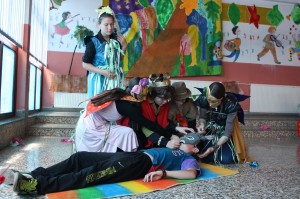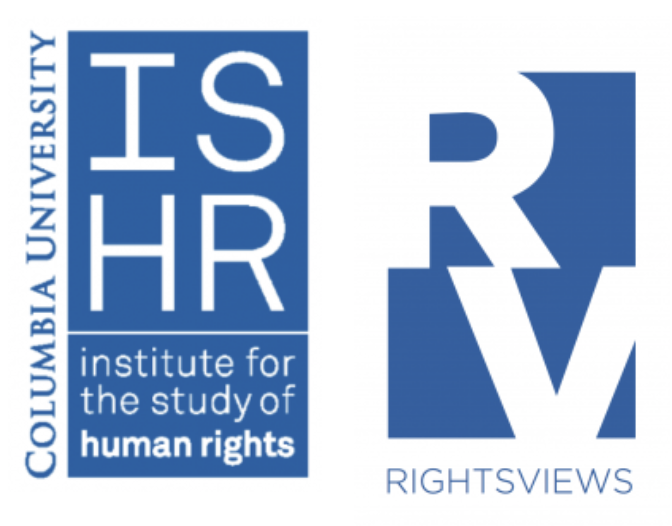By Janine White, Program Coordinator for the Institute for the Study of Human Rights at Columbia University

From May 23-28, 2013, I participated in the Most Mira–Humanity in Action (HIA) International Exchange. Most Mira (Bridge of Peace) is a peacebuilding NGO in northern Bosnia, and its founder, Kemal Pervanic, was a 2012 participant ISHR’s Human Rights Advocates Program. HIA is a human rights education NGO based in the US and with offices in several European countries, including Bosnia. Through this project, HIA Senior Fellows supported Most Mira’s annual youth arts festival, involving children in a drama program that culminated in a rendition of A Midsummer Night’s Dream. During the 5-day festival, Senior Fellows and Most Mira staff, along with other experts in this field, also came together to discuss the challenges and opportunities that this local NGO faces within the current political context in post-conflict Bosnia.
This blog post, previously published here, is a summary of my impressions and reflections from this experience.
A theme that struck me throughout many of our conversations is the idea that disagreements over the narrative of what happened here during the war are a main challenge that continues to perpetuate the divide between different ethnic groups in Bosnia. Most Mira’s work is so important in this context. While the organization is not directly working on changing these narratives, their projects that engage youth through art develop both individual creativity and relationships between segregated young people. I think that this is an important first step in order to create space for people from different sides of the conflict to come together, to listen to and learn from one another. In the broader effort towards reconciliation, as one Most Mira trustee said, we have to trust the process. It seems to me that using art to open up those lines of communication is a way to start.
If you pay attention, signs of the legacy of the war can be found all over Kevljani and its neighboring towns and villages. Driving down the road towards this small village, you see ruined buildings untouched since they were stripped of everything valuable during the war. With just door frames and bathroom tiles on part of a wall remaining, it’s clear that the inhabitants either were killed or have not returned because they’ve made their lives in the places to which they were displaced. Other houses are rebuilt, and you can see that the construction is new, but the lights are off. Many of these people have chosen to stay in the UK, Germany, Sweden, the US, largely because they find more economic opportunities there. They make their lives in a new place and maintain this house as home even though they don’t live there, while their children often identify less with Bosnia than with these other countries. Even for those who have returned, the buildings on their property make the memory of the war physically ever-present. Across the street from the house in which we stayed, a reconstructed home stands next to a half-built/half-destroyed structure. Why not just tear down this building and start from scratch? The clothesline hanging from the upper floor with laundry drying on it shows that this property is inhabited, but it seems that other than fulfilling this small function, the building serves no other purpose than to remind the residents of their recent past.
I wonder what it’s like for these kids to grow up in a place so marked by a war that happened before they were born. It’s their community’s and families’ pasts and yet not their personal memories that you find signs of everywhere. These children’s parents were on different sides of the conflict, but the kids neither perpetrated nor were directly victimized by the war. And yet they’re being kept apart, fed different versions of the story with few opportunities to figure out for themselves what this past means to them, and to experience the humanity of “the other side.”
This is where Most Mira’s work comes in. Engaging through art, music, drama, these young people don’t just meet kids living 5 minutes down the road with whom they might otherwise never have the chance to have a conversation. They get to create something together. They don’t talk politics or about the war, but working on these art projects directly counters the war’s effects: one side’s dehumanizing of the other. Writing the music, painting the set, interviewing cast members, and practicing lines of their play, these kids have an opportunity to express themselves and to share their humanity with others. Art “rehumanizes” the children of those who were targeted because of their identity, and it allows the children of those who perpetrated these crimes to see the humanity in members of the group that their parents may have victimized. And all of this is happening without anyone using the words “Serb” or “Muslim.”
The kids’ performance of San Svake Noći (A Midsummer Night’s Dream) was such a great example of this. The teamwork involved to create and deliver the show was so clear. It was also beautiful to watch how the show evolved throughout the course of the 5 performances. Not understanding the language of the play, I could still see how the kids responded to the audience, how they visibly became more comfortable as each performance progressed, allowing them to improvise with each other. Even though we only had the opportunity to engage with them at the end of their 4-month long project, it also definitely seemed as though new friendships were forged. I worked with one of the girls in the media group, and in her interviews with the other participants, she was quite excited to ask them about the new friends they had made. It didn’t seem important which schools they were from, except for when they had the opportunity to share the play on their own turf. Their sense of accomplishment shone through as they received rounds of applause from parents, teachers, principals, Most Mira and HIA participants, and perhaps most importantly, their fellow students. I loved watching the rapture on the faces of kids in the audience and hearing the laughter erupt at the jokes made and pranks played on stage.
This interaction between the audience and the project participants allows this program to have an effect beyond the 40 children involved in the play. We were all able to see the fruits of their individual creativity, and I hope that the end result, the art that they created together, can instill some hope for the future of these children and their communities. They’re building bridges between each other. A seed of creativity has been planted, and hopefully it will be nurtured so that these kids can continue to explore new ways of interacting, growing from this basis of recognizing their common humanity. This process may not directly lead to new ways of engaging with memories of the past, but I think it’s where a process of reconciliation might be able to start. We learned a lot about the various significant political, economic, and social obstacles that exist in Bosnia today, blocking this process. Considering these challenges, I might sound a bit idealistic in saying that this dialogue and creative experience could encourage these kids to imagine and even achieve a more reconciled future. However, I believe in the healing power of art. And if you don’t start somewhere, you can pretty much guarantee that nothing will happen, but if you try, you at the very least give them a chance to develop a new, and hopefully more inclusive, story.
Check out the report, Creative Commons: Engaging Youth in Peacebuilding through Art in Bosnia and Herzegovina, that we published as part of the Most Mira – Humanity in Action International Exchange.
Janine supports ISHR’s Education Program and Gender and Human Rights Program, in addition to working on communications for the Institute. She is also a Humanity in Action Senior Fellow, having completed the summer fellowship program in 2009.
